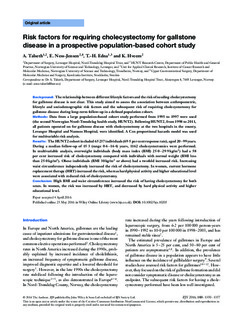| dc.contributor.author | Talseth, Arne | |
| dc.contributor.author | Ness-Jensen, Eivind | |
| dc.contributor.author | Edna, Tom-Harald | |
| dc.contributor.author | Hveem, Kristian | |
| dc.date.accessioned | 2018-02-05T11:35:51Z | |
| dc.date.available | 2018-02-05T11:35:51Z | |
| dc.date.created | 2016-11-07T16:15:39Z | |
| dc.date.issued | 2016 | |
| dc.identifier.citation | British Journal of Surgery. 2016, 103 (10), 1350-1357. | nb_NO |
| dc.identifier.issn | 0007-1323 | |
| dc.identifier.uri | http://hdl.handle.net/11250/2482603 | |
| dc.description.abstract | Background:The relationship between different lifestyle factors and the risk of needing cholecystectomyfor gallstone disease is not clear. This study aimed to assess the association between anthropometric,lifestyle and sociodemographic risk factors and the subsequent risk of requiring cholecystectomy forgallstone disease during long-term follow-up in a defined population cohort.
Methods:Data from a large population-based cohort study performed from 1995 to 1997 were used(the second Norwegian Nord-Trøndelag health study, HUNT2). Following HUNT2, from 1998 to 2011,all patients operated on for gallstone disease with cholecystectomy at the two hospitals in the county,Levanger Hospital and Namsos Hospital, were identified. A Cox proportional hazards model was usedfor multivariable risk analysis.
Results:The HUNT2 cohort included 65 237 individuals (69⋅5 per cent response rate), aged 20–99 years.During a median follow-up of 15⋅3(range0⋅6–16⋅4) years, 1162 cholecystectomies were performed.In multivariable analysis, overweight individuals (body mass index (BMI) 25⋅0–29⋅9 kg/m2)hada58per cent increased risk of cholecystectomy compared with individuals with normal weight (BMI lessthan 25⋅0 kg/m2). Obese individuals (BMI 30 kg/m2or above) had a twofold increased risk. Increasingwaist circumference independently increased the risk of cholecystectomy. In women, current hormonereplacement therapy (HRT) increased the risk, whereas hard physical activity and higher educational levelwere associated with reduced risk of cholecystectomy.
Conclusion:High BMI and waist circumference increased the risk of having cholecystectomy for bothsexes. In women, the risk was increased by HRT, and decreased by hard physical activity and highereducational level. | nb_NO |
| dc.language.iso | eng | nb_NO |
| dc.publisher | Wiley | nb_NO |
| dc.rights | Navngivelse 4.0 Internasjonal | * |
| dc.rights.uri | http://creativecommons.org/licenses/by/4.0/deed.no | * |
| dc.title | Risk factors for requiring cholecystectomy for gallstone disease in a prospective population-based cohort study | nb_NO |
| dc.type | Journal article | nb_NO |
| dc.type | Peer reviewed | nb_NO |
| dc.description.version | publishedVersion | nb_NO |
| dc.source.pagenumber | 1350-1357 | nb_NO |
| dc.source.volume | 103 | nb_NO |
| dc.source.journal | British Journal of Surgery | nb_NO |
| dc.source.issue | 10 | nb_NO |
| dc.identifier.doi | 10.1002/bjs.10205 | |
| dc.identifier.cristin | 1398200 | |
| dc.description.localcode | © 2016 The Authors. BJS published by John Wiley & Sons Ltd on behalf of BJS Society Ltd. This is an open access article under the terms of the Creative Commons Attribution-NonCommercial License. | nb_NO |
| cristin.unitcode | 194,65,20,0 | |
| cristin.unitcode | 194,65,15,0 | |
| cristin.unitcode | 194,65,1,0 | |
| cristin.unitcode | 194,65,20,15 | |
| cristin.unitname | Institutt for samfunnsmedisin og sykepleie | |
| cristin.unitname | Institutt for klinisk og molekylær medisin | |
| cristin.unitname | MH fakultetsadministrasjon | |
| cristin.unitname | Helseundersøkelsen i Nord-Trøndelag | |
| cristin.ispublished | true | |
| cristin.fulltext | postprint | |
| cristin.qualitycode | 2 | |

